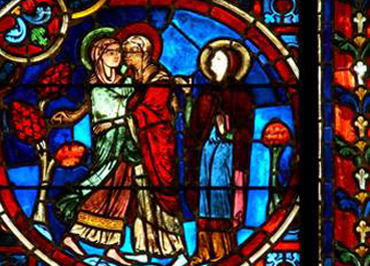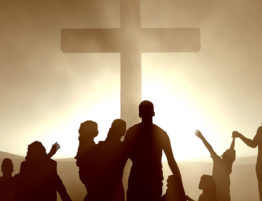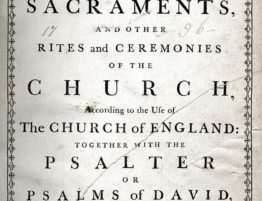
This past Thursday we began the season of Epiphanytide in our Church Calendar. Often, we will celebrate the Feast of the Epiphany itself on the Sunday within its Octave. But this year, we had a midweek celebration of Communion for the Epiphany, giving us an opportunity to look at the Gospel, Epistle, and Collect for the 1st Sunday After Epiphany. But first, we need to answer the question: what is the Epiphany, and what is Ephiphanytide?
The Feast of the Epiphany is sometimes known as “Three Kings’ Day” (Día de los Tres Reyes) because we remember the visitation of the Magi to worship the infant (or, more probably, toddler) Jesus. We know the story from Matthew’s Gospel well: the Magi, or Wise Men, see a unique star in the East and follow it to the Holy Land. The initially go to Jerusalem and talk with King Herod. Herod’s scribes tell the Magi that the Scriptures prophesy that the heir to King David’s throne, the promised Messiah, would be born in Bethlehem. Before the Magi set out to Bethlehem, Herod tells them to report back to him so that he, too, could go worship the Messianic King. Herod’s motives, however, were ulterior: he really wanted to kill Jesus so that there would be no competition to Herod’s kingship. But God thwarts Herod’s plans: he warns the Magi to return to their own country by an alternate route rather than return to Herod. In his rage, Herod slaughters all the infants and toddlers in Bethlehem (as we commemorated in the Feast of the Holy Innocents on December 29th), but the Holy Family escapes to Egypt after also being warned by God through a dream. As we read last Sunday, the Holy Family does not return to Galilee or Judea until after Herod’s death.
Our Collect for the Octave of the Epiphany speaks to the main theological point we are to get from this story. We prayed:
O God, who by the leading of a star didst manifest thy only-begotten Son to the Gentiles; Mercifully grant that we, who know thee now by faith, may after this life have the fruition of thy glorious Godhead; through the same thy Son Jesus Christ our Lord. Amen.
The Magi were not Jews; they were gentiles. They were from the pagan lands, probably Persia (modern-day Iran). While they may have encountered the Hebrew Scriptures due to the Jews’ exile in Babylon and Persia in prior centuries, the Magi were probably not worshipers of the God of the Bible. They were almost certainly pagans of one sort or another. As Magi, they were probably astrologers, magicians, or wizards. Yet God reaches out to them through the miraculous star and brings them to the Jewish Messiah. They are brought to God-made-flesh and worship him. They are among the earliest of those who recognize Jesus for who he is, and they are thus brought into the family. While it would be a few decades before the Gospel begins to spread among the gentiles, the Magi are the firstfruits of that spiritual harvest. The Epiphany celebrates the manifestation of Christ to the Gentiles.
The manifestation or revelation of Christ is the overarching theme of Epiphanytide. Over the next few weeks we will see a number of these pivotal times of Jesus being revealed to his people in various stories from the early chapters of the Gospels. While some of this occurs in the order we find it in Scripture, the nature of the Church calendar is that there are a few episodes in Jesus’ manifestation stories that are not shown in biblical order. This is especially true of that larger story related to the Magi. On December 29 we remember Herod’s reaction to the Magi’s visit. Last Sunday we read about the Holy Family’s return from Egypt after Herod’s death, and this past Thursday we celebrated the visitation of the Magi, which began that larger story. That is, we read the 2nd part of the story first, the 3rd part next, and the 1st part last!
Today’s Gospel for the first Sunday after Epiphany is another such example of the story being read a bit out of order. In a few weeks we will celebrate the Feast of the Purification of the Blessed Virgin Mary, in which we remember the first manifestation of Jesus in the Temple when he was just a few weeks old. But today’s Gospel shows us the second manifestation of Jesus in the Temple when he was twelve years old. Please turn in your bibles to Luke 2:41 (page 110 in the Prayer Book):
Now [Jesus’] parents went to Jerusalem every year at the feast of the Passover. And when he was twelve years old, they went up to Jerusalem after the custom of the feast. And when they had fulfilled the days, as they returned, the child Jesus tarried behind in Jerusalem; and Joseph and his mother knew none of it. But they, supposing him to have been in the company, went a day’s journey; and they sought him among their kinsfolk and acquaintance. And when they found him not, they turned back again to Jerusalem, seeking him. And it came to pass, that after three days they found him in the temple, sitting in the midst of the doctors, both hearing them, and asking them questions. And all that heard him were astonished at his understanding and answers. And when they saw him, they were amazed: and his mother said unto him, Son, why hast thou thus dealt with us? Behold, thy father and I have sought thee sorrowing. And he said unto them, How is it that ye sought me? Wist ye not that I must be about my Father’s business? And they understood not the saying which he spake unto them. And he went down with them, and came to Nazareth, and was subject unto them: but his mother kept all these sayings in her heart. And Jesus increased in wisdom and stature, and in favour with God and man.
If the Feast of the Epiphany celebrated the manifestation of Christ to the Gentiles, both of the childhood manifestations of Christ in the Temple are to the faithful among Israel. At the Purification or Presentation when Jesus was a baby, Christ is revealed to the aged prophets Anna and Simeon, an event we remember at every evensong or compline when we chant or recite the Nunc Dimitis, the Song of Simeon. In today’s Gospel, Christ is manifested to the faithful “doctors” or Scripture Scholars who are studying and discussing God’s word in God’s house. Indeed, we can see that Mary and Joseph were themselves part of the faithful in the Temple.
Though this is hardly the main point of today’s Gospel, notice the piety of Mary and Joseph in this passage. Despite the notorious corruption of the Temple system in those days, despite living far away in Nazareth of Galilee, Mary and Joseph kept the Passover in Jerusalem with their kinsfolk, as per the Law of Moses. Indeed, Mary wasn’t technically required to make the journey according to the Law, but she did so anyway. At age 12, Jesus wasn’t required to be there either, but Mary and Joseph brought him. As parents, grandparents, godparents, teachers, aunts and uncles, or even family friends, let us follow the example of the Holy Family: let us bring our children to church. Kids will pick up on our priorities. They’ll pick up whether worship and fellowship are important to us. And when we do bring them into God’s house, they pick up on many of the external things of our faith, even if they don’t yet fully internalize them. I must confess that I have not always been very faithful in leading my family in devotion time at home. But I’ve seen that Leah and Tori, even as early as age two, picked up the Lord’s Prayer, the Creed, and many other things just by being in church. And when it comes to songs and hymns, the children pick them up better than I do! It’s OK if the kids get fussy in church. We don’t mind. Even in the fussiness, they’re learning about the Lord. When we baptize them, we promise to raise them in the faith; at the very least that means bringing them to church.
But what of the faithful teachers, scholars and doctors in the temple? The Church Fathers make much of Jesus listening to the teachers in the Temple. After all, as a minor, as a mere boy, this is his proper role among his elders, even though the Temple is his Father’s (and by extension, his) house. Jesus, who is God-in-flesh, God-with-us, the Royal heir of David’s throne, prophesied to be worshiped in and reign from the Temple, has humbled himself to listen to the teachers, asking them questions, and taking the position of a learner. But he’s also answering their questions, giving them the spiritual wisdom that they need, even though they hardly would expect a mere boy to be able to do so.
Notice also, Jesus’ answer to his mother when she finds him: “Why were you looking for me? Did you not know that I must be in my Father’s house?” If you want to find Jesus, look for him in God’s house. Look for him in the places where he’s promised to be found. It is in God’s house where Jesus will be manifested to us.
One of the strange things about our culture is that folks often think they can dictate terms to God, expecting God to meet them where they want to be rather than going where God is. We think we can shape God into our image rather than being shaped in his. “I don’t have to go to church,” you may have heard. “I can find God in the fishing boat, or on the hiking trail, or at Starbucks with my friends.” And while it’s true that God is everywhere, good things like fishing, hiking, or coffee aren’t the same as meeting God in his own house.
We find three primary ways Jesus has promised to meet us, to be manifested to us, in his Father’s house.
First, he meets us in the assembled body of Christians, the body of Christ, who gather together to worship him and represent him. Most of us know Matthew 18:20 that says, “For where two or three are gathered in my name, there am I among them.” But remember that the context of this passage is the Church meeting to exercise its judgement as Christ’s Body. Here’s the passage in context:
If your brother sins against you, go and tell him his fault, between you and him alone. If he listens to you, you have gained your brother. But if he does not listen, take one or two others along with you, that every charge may be established by the evidence of two or three witnesses. If he refuses to listen to them, tell it to the church. And if he refuses to listen even to the church, let him be to you as a Gentile and tax collector. Truly, I say to you, whatever you bind on earth shall be bound in heaven, and whatever you loose on earth shall be loosed in heaven. Again I say to you, if two of you agree on earth about anything they ask, it will be done for them by my Father in heaven. For where two or three are gathered in my name, there am I among them.
Do you see how this implies an organized group of Christians with structure and actual spiritual authority? This isn’t merely a bible study group. This isn’t me-and-Jesus going it alone. No, this is the Church, gathered as Christ’s body, which has the promise of his presence.
We also see Jesus present through the work of the Holy Spirit in the proclamation of God’s Word. This is the second way in which Jesus’ presence is manifested in Church. There is something powerful about the teaching, preaching, and reading of God’s word by God’s people who are gathered to meet him. St. Paul writes in Romans 10:13-17:
For “everyone who calls on the name of the Lord will be saved.” How then will they call on him in whom they have not believed? And how are they to believe in him of whom they have never heard? And how are they to hear without someone preaching? And how are they to preach without being sent? As it is written, “How beautiful are the feet of those who preach the good news!” But they have not all obeyed the gospel. For Isaiah says, “Lord, who has believed what he has heard from us?” So faith comes by hearing, and hearing through the word of Christ.
Third, we have the Sacrament of Holy Communion, in which we receive Christ’s body and blood when we come to him by faith with thanksgiving. St. Paul writes in 1 Corinthians 11:16-18:
The cup of blessing that we bless, is it not a participation in the blood of Christ? The bread that we break, is it not a participation in the body of Christ? Because there is one bread, we who are many are one body, for we all partake of the one brad. Consider the people of Israel: are not those who eat the sacrifices participants in the altar?
Indeed, just as the Israelites met the Lord in the altar of the Temple, so do we meet Jesus at his Table in Church. And note how humble all these meetings of Jesus are: Jesus present among his imperfect people: Jesus’ people fall into the same problems as the rest of the world, we’re just as silly as everyone else. Jesus present in the reading and preaching of the bible: the bible is the most printed and easily bought book in most places, and preachers are everywhere! Jesus present in the bread and wine of Communion: especially in times past, no food was more widely eaten than bread and wine. Yet, in all these things Jesus meets us and is manifested to us in special ways, all of which are to be found in his Father’s house. All of which are found in Church.
We, too, humble ourselves when we come into God’s house. In our Epistle, St. Paul exhorted us to “present your bodies a living sacrifice, holy, acceptable unto God.” Or, as we pray in the Communion, we offer to God “ourselves; our souls and bodies.” We don’t come before God insisting on our own way, but following the example of Jesus, who humbled himself for us, we also become like a servant so that we can be exalted with him.
This is why we come before his table kneeling. This is why we make ourselves small before our Lord, remembering that he did the same for our sakes, coming as a humble baby, coming into the Temple as a mere boy, reminding us that we, too, are mere children before God. Small, learning, but nevertheless, co-heirs with God the Son, adopted into his family, and brought into his house.
In the Name of the Father, and of the Son, and of the Holy Ghost. Amen.




